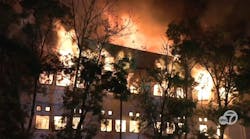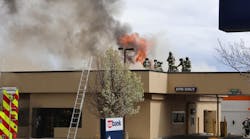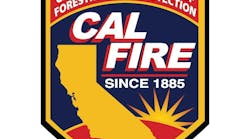An explosion? At a vehicle fire? This was to be a standard operation…! Further investigation reveals a small hazardous materials label on the front bumper with the number 1075 on it. This was no routine vehicle fire. The vehicle was propane-powered. The explosion occurred when the fuel cylinder in the trunk failed. Fortunately, the closed trunk contained the failed cylinder. Could you have done anything differently?
In an effort to be environmentally friendly, alternate-fueled vehicles are out on the road every day in both urban and rural areas. Your department needs to be aware of their features and how to adjust your SOPs to deal with them. There are vehicles fueled by propane, compressed natural gas, methanol, electricity and hydrogen. Many corporations and public utility companies have entire fleets of alternate-fueled vehicles. Some are dual fueled using gasoline and any combination of the above. Depending on the jurisdiction, these alternate-fueled vehicles may or may not have warning labels or placards on them.
Operating forces need to be aware of the properties of the fuels and how the vehicle fuel system is configured. Firefighters need to know where the fuel storage tank is located as well as where the main and emergency shutoff valves are located. Propane and compressed natural gas systems typically have the fuel tank located in the trunk of passenger vehicles. Trucks or buses may have them somewhere underneath, attached to the frame of the vehicle. Pickup trucks might have the tank in the bed of the truck. Alternate-fuel systems may also contain a relief valve which will vent when the tank is under pressure. The relief valve is an additional hazard to operating units. Firefighters need to be aware of its location in order to protect the operating members.
With the technology offered today, there are no routine operations. Arrive at the scene ready to work…full turnout gear, hood, gloves (firefighting, not extrication), and personal protective equipment (PPE) are mandatory! Learn to expect the unexpected. Regardless of the type of alternate-fueled vehicle you encounter, awareness and location of the hazards present are keys to a safe and successful operation.
Richard J. Blatus is a 23-year veteran of the fire service, currently assigned to Battalion 15 in the Bronx, NY. A strong proponent of training, Chief Blatus has served as both a regional and national instructor/lecturer for fire service trade publications and conferences, such as Firehouse Expo. He holds degrees in business and municipal fire administration.Thomas J. Richardson is a 23-year veteran of the fire service, currently serving the FDNY at Battalion 38 in Brooklyn. A former chief of the Deer Park, NY, Volunteer Fire Department, Chief Richardson is an adjunct instructor for the Suffolk County, NY, Fire Training Academy.









